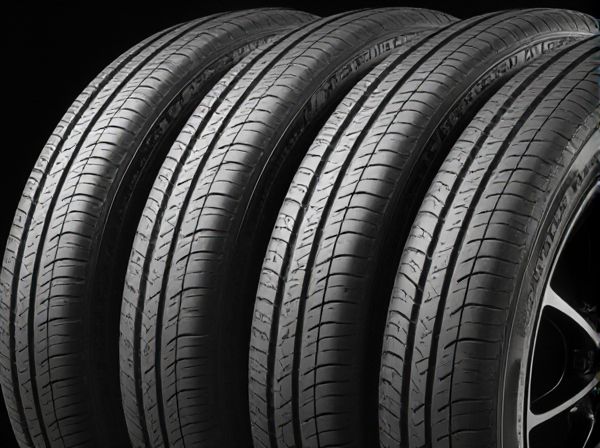
Photo illustration: Puncture-Resistant Tire vs Standard Tire
Puncture-resistant tires feature reinforced sidewalls and thicker tread layers designed to reduce the risk of flats, providing enhanced durability and reliability for your vehicle. Standard tires offer a lighter, more flexible design that often results in a smoother ride but can be more susceptible to punctures from sharp objects. Choosing between the two depends on your driving environment and how much protection you prioritize for your tires.
Table of Comparison
| Feature | Puncture-Resistant Tire | Standard Tire |
|---|---|---|
| Durability | High resistance to punctures and cuts | Moderate, prone to punctures |
| Material | Reinforced rubber compounds with Kevlar or steel belts | Standard rubber with fabric belts |
| Cost | Higher initial purchase price | Lower initial cost |
| Lifespan | Longer due to puncture resistance | Shorter, may require frequent replacements |
| Weight | Slightly heavier due to reinforcements | Lighter weight, standard design |
| Performance | Maintains performance under rough conditions | Performance may degrade with damage |
| Maintenance | Less frequent tire repairs or replacements | More frequent patching or tire changes |
Introduction to Puncture-Resistant and Standard Tires
Puncture-resistant tires incorporate advanced materials such as Kevlar or reinforced rubber layers designed to prevent sharp objects from penetrating the tire, significantly reducing the risk of flats during rides. Standard tires typically utilize basic rubber compounds and lack these protective layers, making them more susceptible to punctures in urban or off-road environments. The enhanced durability of puncture-resistant tires offers extended lifespan and reliability for cyclists or motorists frequently encountering debris or rough terrain.
How Puncture-Resistant Tires Work
Puncture-resistant tires feature reinforced layers such as Kevlar or aramid fibers embedded within the tread and sidewalls, creating a tough barrier against sharp objects that typically cause flats in standard tires. These specialized materials absorb and disperse the force of penetration from nails, glass, and thorns, significantly reducing the likelihood of punctures. Unlike standard tires that rely solely on rubber compounds, puncture-resistant tires combine enhanced structural integrity with advanced tread designs to maintain performance while extending tire lifespan.
Construction Differences Between Tires
Puncture-resistant tires feature reinforced sidewalls and thicker tread layers made from durable materials like Kevlar or aramid fibers that enhance their ability to withstand sharp objects and rough terrain. Standard tires typically have lighter, less robust construction designed for general use, prioritizing weight and ride comfort over penetration protection. The structural variations in puncture-resistant tires significantly improve durability and reduce the risk of flats, making them ideal for off-road and urban environments with debris.
Durability and Longevity Comparison
Puncture-resistant tires feature reinforced sidewalls and advanced rubber compounds that significantly enhance durability by preventing common road hazards like nails and sharp debris from causing flats. Standard tires typically prioritize ride comfort and cost-efficiency, but their thinner tread and lack of protective layers result in a higher risk of punctures and faster wear over time. Consumers seeking extended tire lifespan and reduced maintenance should consider puncture-resistant options, which often deliver superior longevity through reinforced construction and improved resistance to everyday road damage.
Performance in Various Road Conditions
Puncture-resistant tires offer enhanced durability and reliability on rough terrains by minimizing flat tire risks, making them ideal for off-road and urban environments with debris. Standard tires typically provide better fuel efficiency and smoother rides on paved roads but are more susceptible to punctures from sharp objects. Performance in wet or slippery conditions can vary, as puncture-resistant tires often incorporate specialized tread designs to maintain traction without sacrificing toughness.
Safety Features and Benefits
Puncture-resistant tires feature reinforced sidewalls and advanced rubber compounds that significantly reduce the risk of flats, enhancing overall safety by maintaining tire integrity in hazardous conditions. These tires often incorporate Kevlar or other protective layers to prevent sharp objects from penetrating, providing reliable performance on rough terrains. Standard tires lack these specialized reinforcements, making them more vulnerable to punctures, which can lead to sudden blowouts and compromised safety during driving.
Cost Differences and Long-Term Value
Puncture-resistant tires typically have higher upfront costs than standard tires due to advanced materials and specialized construction designed to prevent flats. Over time, the reduced frequency of replacements and lower maintenance costs contribute to greater long-term value, especially for riders frequently encountering rough terrain or debris. Investing in puncture-resistant tires can result in significant savings by minimizing downtime and repair expenses compared to standard tires.
Maintenance Requirements
Puncture-resistant tires require less frequent repairs and replacements compared to standard tires due to their reinforced sidewalls and thicker tread layers. Maintenance primarily involves regular pressure checks and occasional tread inspections, reducing downtime and repair costs. Standard tires demand more frequent puncture repairs and may require earlier replacement, increasing overall maintenance efforts and expenses.
Best Use Cases for Each Tire Type
Puncture-resistant tires are ideal for urban commuting and off-road cycling where sharp debris and rough terrain increase the risk of flats, offering enhanced durability and fewer maintenance interruptions. Standard tires suit road cycling or smooth pavement riding, providing lighter weight and better speed performance in low-risk, controlled environments. Selecting the right tire depends on terrain conditions, frequency of puncture hazards, and the rider's priority between reliability and performance.
Choosing the Right Tire for Your Needs
Puncture-resistant tires feature reinforced sidewalls and specialized rubber compounds that significantly reduce the risk of flats, making them ideal for urban commuting or rough terrains where debris is common. Standard tires offer lighter weight and better rolling efficiency, suitable for smooth roads and casual riding but are more susceptible to punctures. Selecting the right tire depends on your riding conditions, prioritizing durability for frequent off-road use or efficiency and comfort for everyday street cycling.
 caratoz.com
caratoz.com